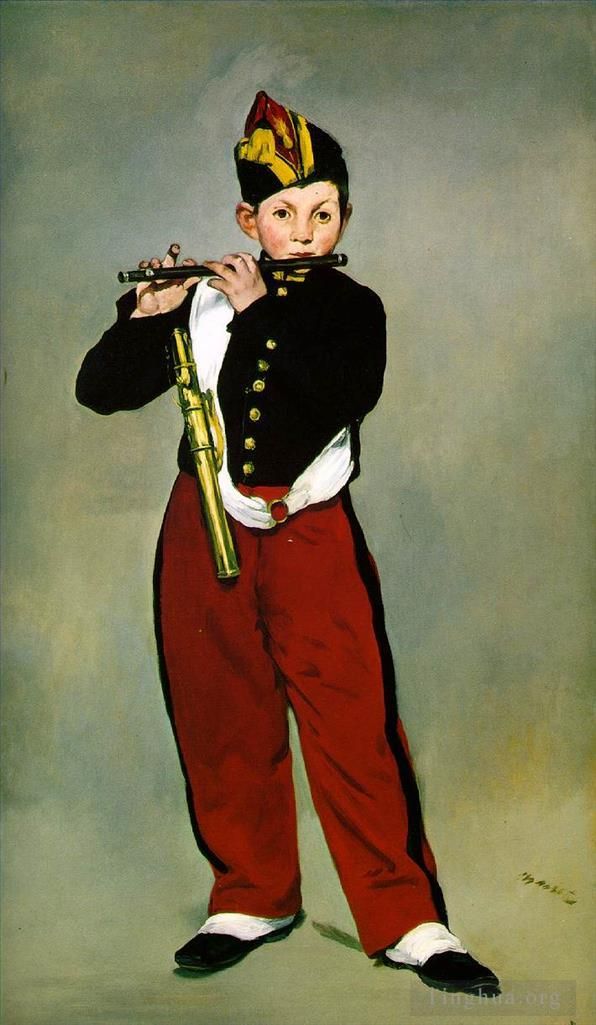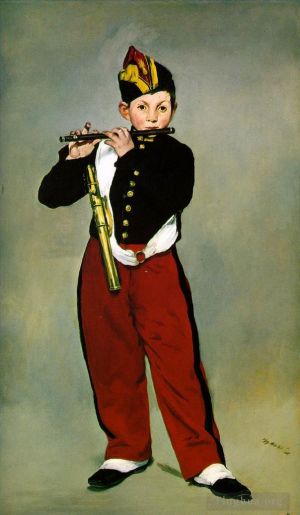The Fifer
Edouard Manet
- Price: Price on Request
- Art Type: Oil Painting
- Size:
- English Comments: 0
- International Comments: 0
- Creating Date:
- Introduction and Works of Edouard Manet >>
Keywords:
Fifer
Work Overview
- The Fifer (Young Flautist)
Artist Édouard Manet
Year 1866
Type oil painting
Dimensions 160 cm × 97 cm (63 in × 38 in)
Location Musée d'Orsay, Paris
The Fifer or Young Flautist is a painting by French painter Édouard Manet, made in 1866. It is currently kept in the Musée d'Orsay, Paris.
On a trip to Spain in 1865, Édouard Manet visited the Prado, where the art of Diego Velázquez was a revelation. Upon his return to Paris in 1866, he began work on a new painting, depicting an anonymous regimental fifer of the Spanish army. In this picture, Manet presents the uniformed boy, in a manner that imitates and inverts the formula of Vélazquez's court portraits, against a barely inflected, flattened background of neutral tone, thus frustrating attempts to assess the figure's true size and, by extension, importance.
The painting, entitled Le fifre, was rejected by the jury of the Salon of 1866. Outraged by the jury's decision, Émile Zola, an early champion of Manet's art, published a series of articles in the newspaper L'Évenement, that praised Manet's realist style and modern content. Following the example of Gustave Courbet, in May 1867, Manet personally funded and mounted an exhibition of his own work in a pavilion at the edge of the Éxposition universelle. The exhibition included Le fifre, which was ridiculed in the popular press for its unusual brushwork and inscrutable spatial setting.
The painting was acquired by Durand-Ruell in 1872 and again in 1893. Between 1873 and 1893, the painting was owned by Manet's friend, composer and baritone Jean-Baptiste Faure. Le fifre was accepted by the French government in lieu of taxes on the estate of its last private owner, the Count Isaac de Camondo, and entered the national collections in 1911. It was displayed at the Louvre from 1914 until 1947, when it was relocated to the Musée du Jeu de Paume. In 1986, it was moved to its current home in the Musée d'Orsay, the national museum of 19th-century art.
It was included in a large exhibition of Manet's work in 1884, a year after his premature death, and was included in the sweeping Manet retrospective held at the Grand Palais in 1983, the 100th anniversary of the artist's death.
As in the painting by Spanish painter, Manet conceived a shallow depth, where vertical and horizontal planes are barely distinguishable.[1] According to Peter H. Feist, in The Player fife, Manet showed the attraction for "the decorative effect of a large single figures, with emphatic contours and placed before a background surface."[2] Before the monochrome background, the figure is strongly highlighted but based on a reduced palette of colors, dominated by the impasto technique: the very sharp black of the jacket and shoes, red pants, white strap, etc.. As a result, the figure stands "firm, smooth and alive."[3][1]
Moreover, as in Velázquez's work, Manet also portrayed an anonymous character, a teenage musician of the band of the Imperial Guard of Napoleon III, who was sent to Manet by commander Lejosne,[4] "treated like a grandee of Spain."[1] Additional models may have also posed for the figure: the likenesses of both Léon Leenhoff and Victorine Meurent have been seen in the boy's face and figure.
-----------------------
The Fifer is a painting from the Realist school of 19th century painting. It was painted by Édouard Manet in 1866. Manet painted in both the Realist and Impressionistic style, and like many innovative artists, was not well-appreciated in his own time. The painting grew in popularity in the 20th century, moving from private collections to the Musee du Jeu de Paume and finally to the Musee d’Orsay, where it is currently displayed.
Description
The 63 inch by 38 inch oil on canvas painting shows a single figure against a stark background. A young boy dressed in a military uniform of red pants, dark jacket with brass buttons, a white sash, and a dark hat with a red cockade, plays a fife (flute). The flute is dark wood with silver fittings, and a brass carrying case for the instrument rests at his right side. The figure is fully illuminated from the front with only a hint of shadow behind him, giving the painting a curious, almost photographic flatness.
History and Technique
Manet was deeply interested in the painting techniques of the Spanish school. In 1865, he traveled to Spain to study the works of Diego Velazquez and other Spanish Renaissance masters. All of his work would show the influence of this study, but none so starkly as The Fifer. Manet dispensed entirely with Renaissance Chiaroscuro for The Fifer, choosing instead to flood his subject with the most direct light and flatten the scene. Dark outlining further flattens the subject, and the pose, taken from French Tarot, adds to the cartoon-like quality of the piece.
Critical Reception
The Fifer, while now recognized as one of the first Early Modern pieces, was totally shocking to its contemporary audience. The great art critic Emile Zola defended it in vain as an expression of artistic innovation and freedom. It would take several decades before anyone agreed with Zola’s analysis.
- Copyright Statement:
All the reproduction of any forms about this work unauthorized by Singing Palette including images, texts and so on will be deemed to be violating the Copyright Laws.
To cite this webpage, please link back here.
- >> English Comments
- >> Chinese Comments
- >> French Comments
- >> German Comments
- >>Report
- Basket of Fruits
- The monk at prayer
- At Father Lathuille
- The Luncheon on the Grass (The Bath)
- The Grand Canal Venice
- Portrait of Emile Zola
- Portrait of Lina Campineanu
- Young Man in the Costume of a Majo
- The Bullfight
- Bench in autumn
- Victorine Meurent in the costume of an Espada
- Portrait of Zacharie Astruc
- Carnations and clematis in a crystal vase
- A boy with a pitcher
- Madame Brunet
- A matador
- On the Beach at Boulogne
- Reading Mme Manet and Leon
- Peaches
- The Kearsarge at Boulogne (Fishing boat coming in before the wind)
- Interior at Arcachon
- The ragpicker
- Woman in furs
- The model
- Madame Manet on a Blue Sofa
- Monet in his Studio Boat (Claude Monet Painting on His Boat-Studio in Argenteuil)
- Guitar and Hat
- The House at Rueil
- The Suicide
- Branch of White Peonies and Pruning Shears
- Jetty at Boulogne
- Portrait of Faure as Hamlet
- The Railway (Gare Saint-Lazare)
- Marguerite de Conflans Wearing Hood
- Theodore Duret
- Steamboat Leaving Boulogne
- Portrait of Gilbert Marcellin Desboutin
- Still Life Fruits on a Table
- The garden around Manet house
- Corner of a Café-Concert
- Boy with Dog
- Portrait of Mademoiselle Claus
- Young woman with a pink shoe
- Le Bon Bock A Good Glass of Beer
- Boy Blowing Bubbles
- Berthe Morisot with a Bouquet of Violets
- Portrait of Monsieur Brun
- Portrait of Emilie Ambre in the role of Carmen
- Effect of Snow at Petit Montrouge
- Vase of White Lilacs and Roses
- View of the 1867 Exposition Universelle
- Study of trees
- Moss Roses in a Vase
- Angelina
- Roses in a Champagne Glass
- Spring Study of Jeanne Demarsy
- The barque of Dante Copy after Delacroix
- The Street Singer
- Singer at a Cafe Concert
- Baudelaires Mistress Reclining Study of Jeanne Duval
- The Lemon
- Repose Study of
- A Game of Croquet
- Polichinelle
- Masked Ball at the Opera
- Bundle of Asparagus
- The Departure Of The Folkestone Boat
- The spanish ballet
- Argenteuil
- Plum
- At the Cafe
- Bench
- Gypsy with a Cigarette
- Rose and tulip
- Vase of Peonies on a Small Pedestal
- The Dead Christ with Angels
- Stephane Mallarme
- Nana
- Music in the Tuileries
- Christ with Angels
- Madame Manet in conservatory
- Swallows
- The Luncheon in the Studio
- Flowers in a Crystal Vase
- Madame Manet at the Piano
- Rochefort Escape
- The philosopher
- Still Life with Brioche
- Lola de Valence
- Bull fighting scene
- Portrait of Eva Gonzales
- Bouquet of flowers
- Eva Gonzales
- The Spanish Singer The Guitar Player
- Portrait of Mademoiselle Isabelle Lemonnier
- The Blonde with Bare Breasts
- The Waitress
- Woman with umbrella
- Young woman in the garden
- A Corner of the Garden in Rueil
- Madame Manet at Bellevue
- The Rest portrait of
- Woman Reading
- Bathers on the Seine
- Two Roses on a Tablecloth
- Le Chemin De Fer The Railroad
- The burial
- Execution of the Emperor Maximilian
- Embarkation after Folkestone
- Portrait of Henry Bernstein as a Child
- Head of a Dog
- The head of Christ
- Mother in the Garden at Bellevue
- Autumn Study of Mery Laurent
- The Races in the Bois de Boulogne
- Still life with melon and peaches
- Woman Before a Mirror
- Jesus Mocked by the Soldiers
- Flowers In A Crystal Vase flower Impressionism Edouard Manet
- The Port of Bordeaux
- A brioche
- Rue Mosnier decorated with Flags
- The Banks of the Seine at Argenteuil
- Lilac in a glass
- Woman Pouring Water Study of Suzanne Leenhoff
- The Monet family in their garden at Argenteuil
- View of Holland
- Portrait of Antonin Proust Realism Impressionism Edouard Manet
- Boating
- A King Charles Spanie
- Peonies in a vase
- The Horsewoman
- M and Mme Auguste Manet
- The conservatory
- Woman in a Tub
- A young man peeling a pear
- The Jetty at Boulogne
- Interior of a Cafe
- The ham
- On The Beach
- Pertuiset Lion Hunter
- The grand canal of Venice
- Oysters
- The Execution of the Emperor Maximilian of Mexico
- In the garden
- Portrait of Antonin Proust
- Victorine Meurent
- Young woman with a book
- Tarring the Boat
- Young woman in a round hat
- The Races at Longchamp
- The Milliner
- At the races
- The absinthe drinker
- Olympia
- Seascape at Berck Fishing Boats and Fishermen
- The old musician
- The Balcony
- Fishing
- Madame Auguste Manet
- The Boy with Cherries
- The Fifer
- Women at the Races
- Portrait of Suzanne Manet
- Surprised Nymph
- Portrait of Monsieur Tillet
- Almonds currants and peaches
- The stroll
- Young Woman in Oriental Garb
- Battle of Kearsage and Alabama
- The road menders Rue de Berne
- Woman with a Parrot
- Boy with a sword
- Eel and Red Mullet
- Woman with Fans (The Lady with Fans or Portrait of Nina de Callias)
- The Café-Concert (At the Café or The Bock Drinkers)
- The salmon
- Seascape at Arcachon
- The Garden at Bellevue
- The dead toreador
- Young Woman Reclining in Spanish Costume
- Young woman among the flowers
- Woman fastening her garter
- A Bar at the Folies-Bergère
- Bouquet Of Violets still life Impressionism Edouard Manet
- The Port of Bordeaux 2
- Head Of A Man
- Young woman in a negligee
- Portrait Of Mme Jules Guillemet
- On the Bench
- The Barricade Civil War









 Singing Palette
Singing Palette